Abstract
1. SB 206553 (5-methyl-1-(3-pyridylcarbamoyl)-1,2,3,5-tetrahydropyrrolo[2 ,3-f]indole) displays a high affinity (pK1 7.9) for the cloned human 5-HT2C receptor expressed in HEK 293 cells and the 5-HT2B receptor (pA2 8.9) as measured in the rat stomach fundus preparation. SB 206553 has low affinity for cloned human 5-HT2A receptors expressed in HEK 293 cells (pK1 5.8) and (pK1 < 6) for a wide variety of other neurotransmitter receptors. 2. SB 206553 appears to be a surmountable antagonist of 5-HT-stimulated phosphoinositide hydrolysis in HEK 293 cells expressing the human 5-HT2C receptor (pKB 9.0). 3. The compound potently (ID50 5.5 mg kg-1, p.o., 0.27 mg kg-1, i.v.) inhibited the hypolocomotor response to m-chlorophenylpiperazine (mCPP), a putative model of 5-HT2C/5-HT2B receptor function in vivo. 4. At similar doses (2-20 mg kg-1, p.o.) SB 206553 increased total interaction scores in a rat social interaction test and increased punished responding in a rat Geller-Seifter conflict test. These effects are consistent with the possession of anxiolytic properties. 5. SB 206553 also increased suppressed responding in a marmoset conflict model of anxiety at somewhat higher doses (15 and 20 mg kg-1, p.o.) but also reduced unsuppressed responding. 6. These results suggest that SB 206553 is a potent mixed 5-HT2C/5-HT2B receptor antagonist with selectivity over the 5-HT2A and all other sites studied and possesses anxiolytic-like properties.
Full text
PDF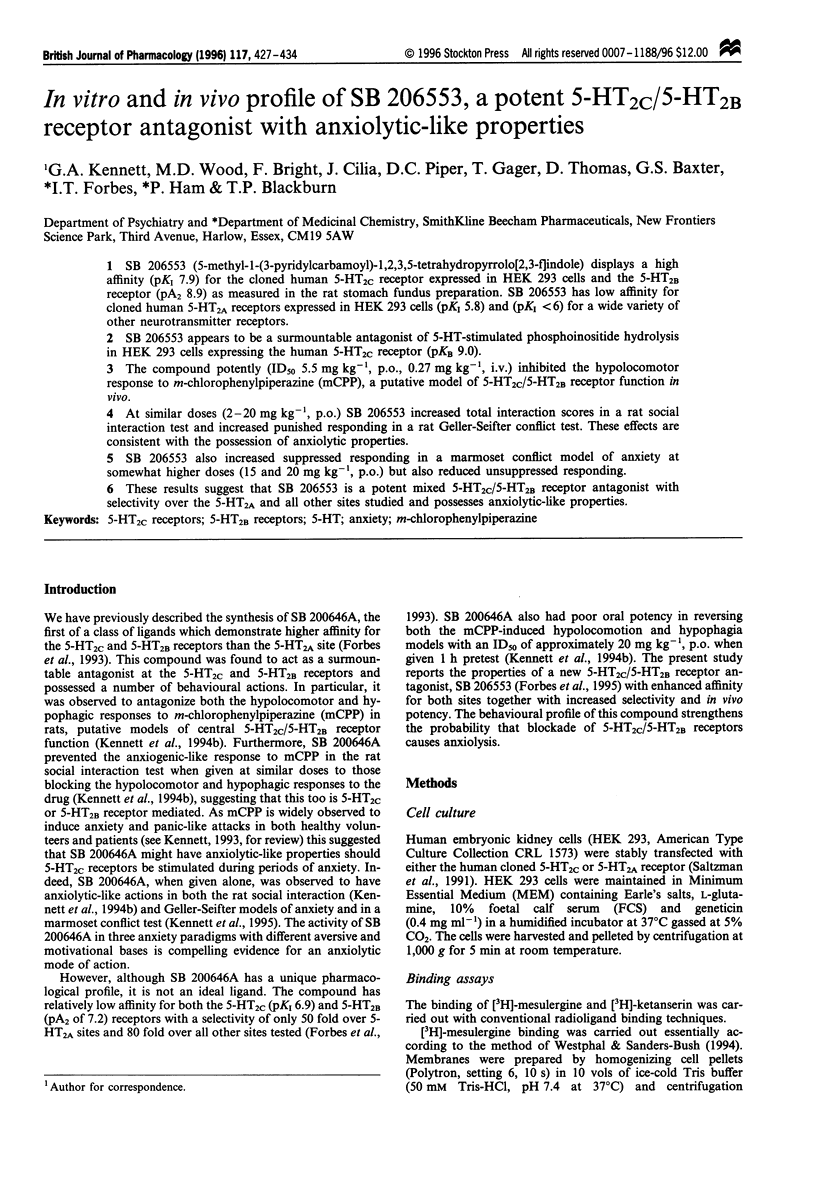

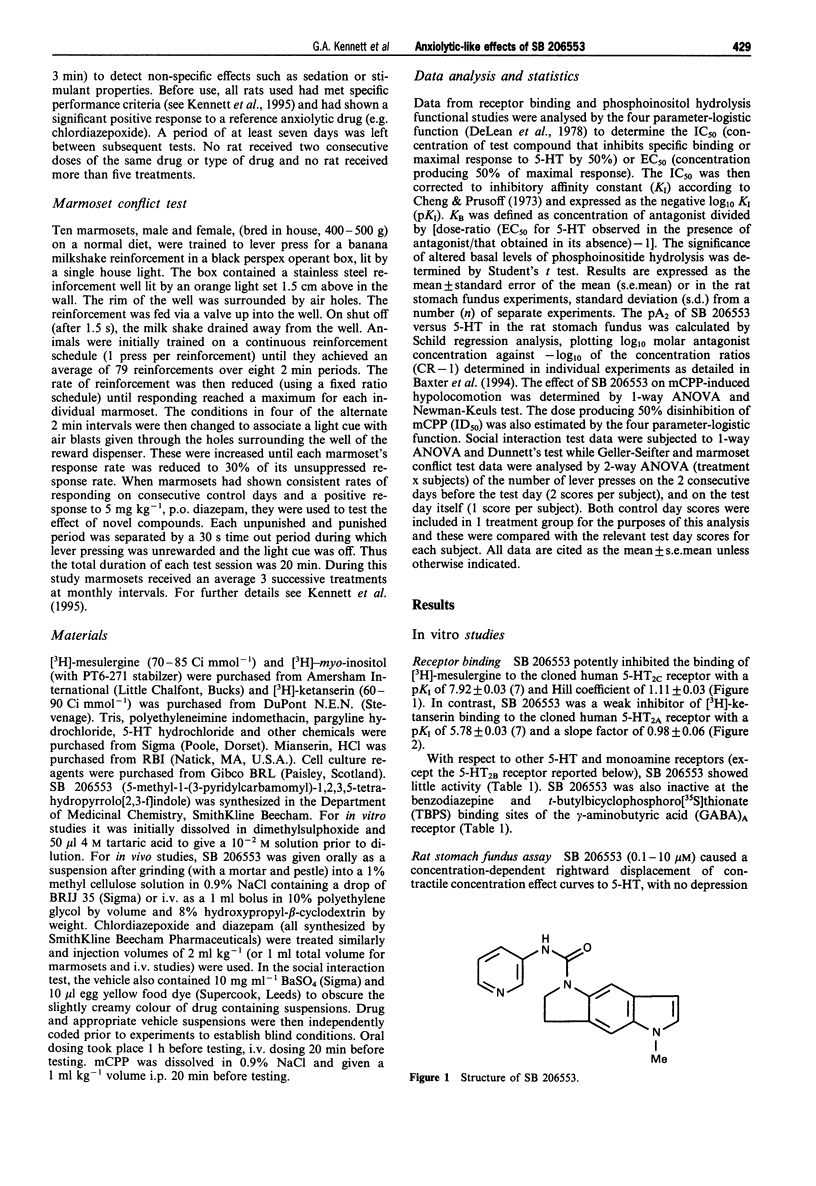
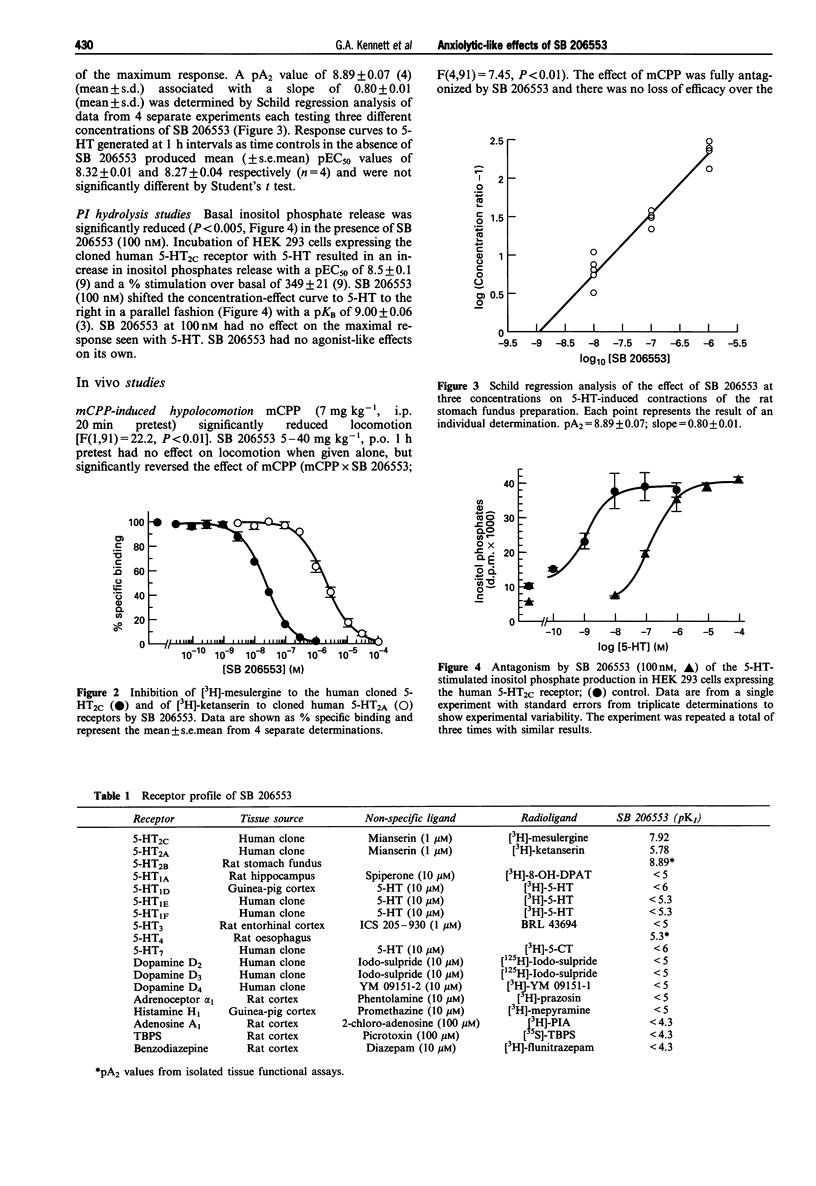
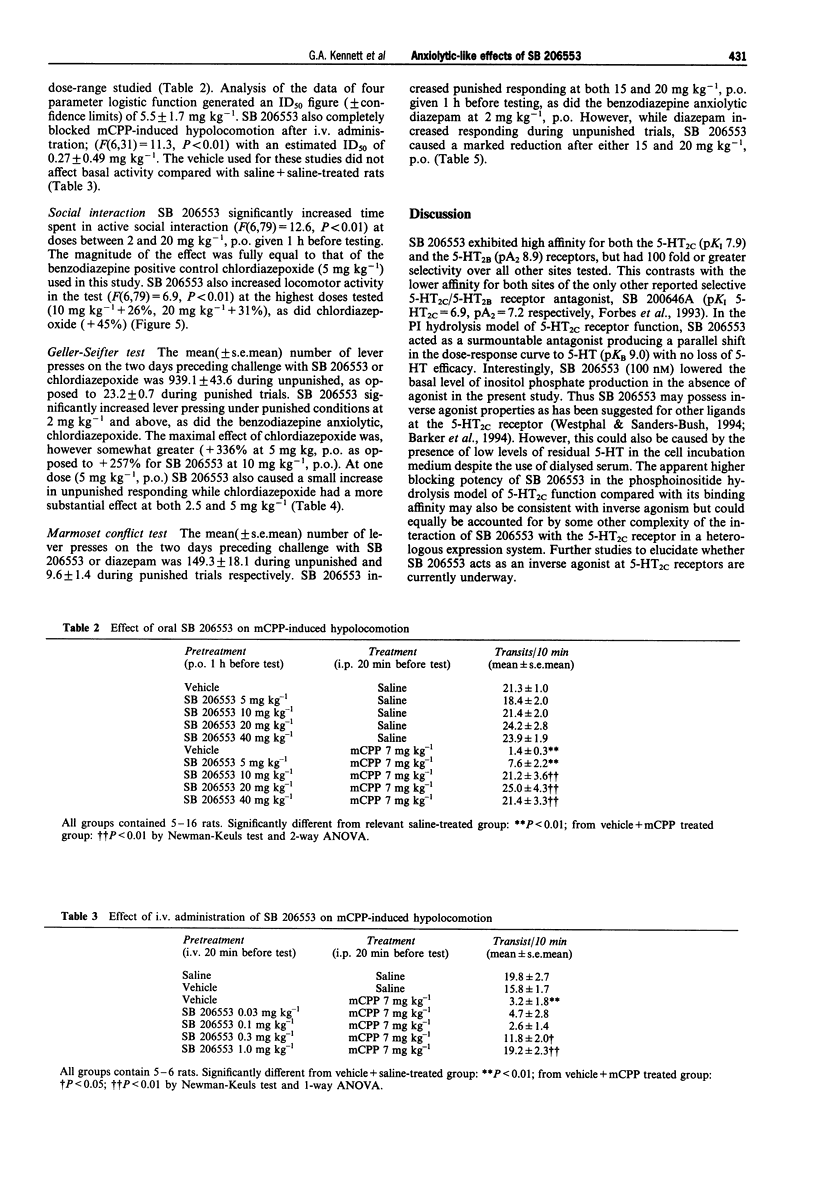
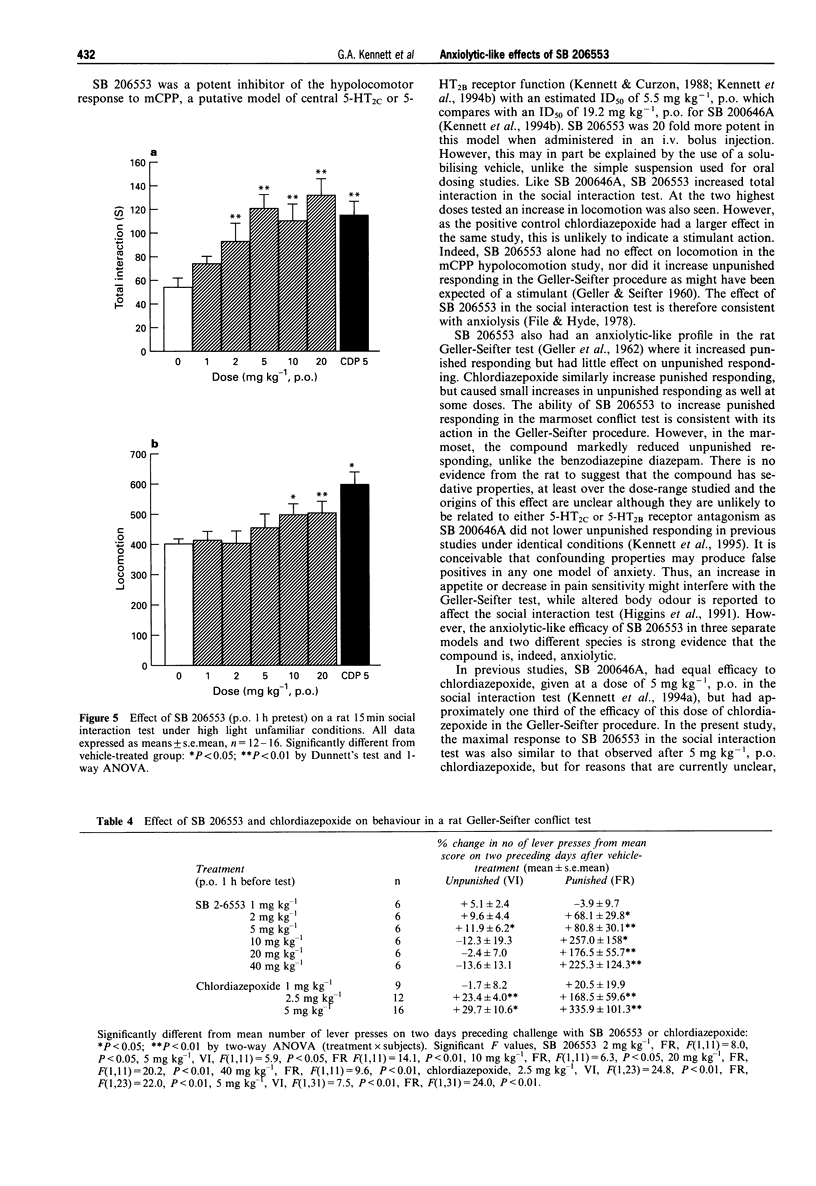


Selected References
These references are in PubMed. This may not be the complete list of references from this article.
- Adham N., Kao H. T., Schecter L. E., Bard J., Olsen M., Urquhart D., Durkin M., Hartig P. R., Weinshank R. L., Branchek T. A. Cloning of another human serotonin receptor (5-HT1F): a fifth 5-HT1 receptor subtype coupled to the inhibition of adenylate cyclase. Proc Natl Acad Sci U S A. 1993 Jan 15;90(2):408–412. doi: 10.1073/pnas.90.2.408. [DOI] [PMC free article] [PubMed] [Google Scholar]
- Barker E. L., Westphal R. S., Schmidt D., Sanders-Bush E. Constitutively active 5-hydroxytryptamine2C receptors reveal novel inverse agonist activity of receptor ligands. J Biol Chem. 1994 Apr 22;269(16):11687–11690. [PubMed] [Google Scholar]
- Baxter G. S., Murphy O. E., Blackburn T. P. Further characterization of 5-hydroxytryptamine receptors (putative 5-HT2B) in rat stomach fundus longitudinal muscle. Br J Pharmacol. 1994 May;112(1):323–331. doi: 10.1111/j.1476-5381.1994.tb13072.x. [DOI] [PMC free article] [PubMed] [Google Scholar]
- Baxter G., Kennett G., Blaney F., Blackburn T. 5-HT2 receptor subtypes: a family re-united? Trends Pharmacol Sci. 1995 Mar;16(3):105–110. doi: 10.1016/s0165-6147(00)88991-9. [DOI] [PubMed] [Google Scholar]
- Brown A. M., Patch T. L., Kaumann A. J. The antimigraine drugs ergotamine and dihydroergotamine are potent 5-HT1C receptor agonists in piglet choroid plexus. Br J Pharmacol. 1991 Sep;104(1):45–48. doi: 10.1111/j.1476-5381.1991.tb12382.x. [DOI] [PMC free article] [PubMed] [Google Scholar]
- Ceulemans D. L., Hoppenbrouwers M. L., Gelders Y. G., Reyntjens A. J. The influence of ritanserin, a serotonin antagonist, in anxiety disorders: a double-blind placebo-controlled study versus lorazepam. Pharmacopsychiatry. 1985 Sep;18(5):303–305. doi: 10.1055/s-2007-1017385. [DOI] [PubMed] [Google Scholar]
- Cheng Y., Prusoff W. H. Relationship between the inhibition constant (K1) and the concentration of inhibitor which causes 50 per cent inhibition (I50) of an enzymatic reaction. Biochem Pharmacol. 1973 Dec 1;22(23):3099–3108. doi: 10.1016/0006-2952(73)90196-2. [DOI] [PubMed] [Google Scholar]
- Clineschmidt B. V., Reiss D. R., Pettibone D. J., Robinson J. L. Characterization of 5-hydroxytryptamine receptors in rat stomach fundus. J Pharmacol Exp Ther. 1985 Dec;235(3):696–708. [PubMed] [Google Scholar]
- DeLean A., Munson P. J., Rodbard D. Simultaneous analysis of families of sigmoidal curves: application to bioassay, radioligand assay, and physiological dose-response curves. Am J Physiol. 1978 Aug;235(2):E97–102. doi: 10.1152/ajpendo.1978.235.2.E97. [DOI] [PubMed] [Google Scholar]
- File S. E., Hyde J. R. Can social interaction be used to measure anxiety? Br J Pharmacol. 1978 Jan;62(1):19–24. doi: 10.1111/j.1476-5381.1978.tb07001.x. [DOI] [PMC free article] [PubMed] [Google Scholar]
- Forbes I. T., Ham P., Booth D. H., Martin R. T., Thompson M., Baxter G. S., Blackburn T. P., Glen A., Kennett G. A., Wood M. D. 5-Methyl-1-(3-pyridylcarbamoyl)-1,2,3,5-tetrahydropyrrolo[2,3-f]indole: a novel 5-HT2C/5-HT2B receptor antagonist with improved affinity, selectivity, and oral activity. J Med Chem. 1995 Jul 7;38(14):2524–2530. doi: 10.1021/jm00014a004. [DOI] [PubMed] [Google Scholar]
- Forbes I. T., Kennett G. A., Gadre A., Ham P., Hayward C. J., Martin R. T., Thompson M., Wood M. D., Baxter G. S., Glen A. N-(1-methyl-5-indolyl)-N'-(3-pyridyl)urea hydrochloride: the first selective 5-HT1C receptor antagonist. J Med Chem. 1993 Apr 16;36(8):1104–1107. doi: 10.1021/jm00060a019. [DOI] [PubMed] [Google Scholar]
- GELLER I., KULAK J. T., Jr, SEIFTER J. The effects of chlordiazepoxide and chlorpromazine on a punishment discrimination. Psychopharmacologia. 1962 Oct 31;3:374–385. doi: 10.1007/BF00408322. [DOI] [PubMed] [Google Scholar]
- Hamblin M. W., Metcalf M. A. Primary structure and functional characterization of a human 5-HT1D-type serotonin receptor. Mol Pharmacol. 1991 Aug;40(2):143–148. [PubMed] [Google Scholar]
- Higgins G. A., Jones B. J., Oakley N. R., Tyers M. B. Evidence that the amygdala is involved in the disinhibitory effects of 5-HT3 receptor antagonists. Psychopharmacology (Berl) 1991;104(4):545–551. doi: 10.1007/BF02245664. [DOI] [PubMed] [Google Scholar]
- Kennett G. A., Bailey F., Piper D. C., Blackburn T. P. Effect of SB 200646A, a 5-HT2C/5-HT2B receptor antagonist, in two conflict models of anxiety. Psychopharmacology (Berl) 1995 Mar;118(2):178–182. doi: 10.1007/BF02245837. [DOI] [PubMed] [Google Scholar]
- Kennett G. A., Curzon G. Evidence that mCPP may have behavioural effects mediated by central 5-HT1C receptors. Br J Pharmacol. 1988 May;94(1):137–147. doi: 10.1111/j.1476-5381.1988.tb11508.x. [DOI] [PMC free article] [PubMed] [Google Scholar]
- Kennett G. A., Pittaway K., Blackburn T. P. Evidence that 5-HT2c receptor antagonists are anxiolytic in the rat Geller-Seifter model of anxiety. Psychopharmacology (Berl) 1994 Feb;114(1):90–96. doi: 10.1007/BF02245448. [DOI] [PubMed] [Google Scholar]
- Loric S., Launay J. M., Colas J. F., Maroteaux L. New mouse 5-HT2-like receptor. Expression in brain, heart and intestine. FEBS Lett. 1992 Nov 9;312(2-3):203–207. doi: 10.1016/0014-5793(92)80936-b. [DOI] [PubMed] [Google Scholar]
- Maksay G. Partial and full agonists/inverse agonists affect [35S]TBPS binding at different occupancies of central benzodiazepine receptors. Eur J Pharmacol. 1993 Aug 15;246(3):255–260. doi: 10.1016/0922-4106(93)90039-c. [DOI] [PubMed] [Google Scholar]
- Pompeiano M., Palacios J. M., Mengod G. Distribution of the serotonin 5-HT2 receptor family mRNAs: comparison between 5-HT2A and 5-HT2C receptors. Brain Res Mol Brain Res. 1994 Apr;23(1-2):163–178. doi: 10.1016/0169-328x(94)90223-2. [DOI] [PubMed] [Google Scholar]
- Saltzman A. G., Morse B., Whitman M. M., Ivanshchenko Y., Jaye M., Felder S. Cloning of the human serotonin 5-HT2 and 5-HT1C receptor subtypes. Biochem Biophys Res Commun. 1991 Dec 31;181(3):1469–1478. doi: 10.1016/0006-291x(91)92105-s. [DOI] [PubMed] [Google Scholar]
- Schmuck K., Ullmer C., Engels P., Lübbert H. Cloning and functional characterization of the human 5-HT2B serotonin receptor. FEBS Lett. 1994 Mar 28;342(1):85–90. doi: 10.1016/0014-5793(94)80590-3. [DOI] [PubMed] [Google Scholar]
- Schoeffter P., Hoyer D. Interaction of arylpiperazines with 5-HT1A, 5-HT1B, 5-HT1C and 5-HT1D receptors: do discriminatory 5-HT1B receptor ligands exist? Naunyn Schmiedebergs Arch Pharmacol. 1989 Jun;339(6):675–683. doi: 10.1007/BF00168661. [DOI] [PubMed] [Google Scholar]
- To Z. P., Bonhaus D. W., Eglen R. M., Jakeman L. B. Characterization and distribution of putative 5-ht7 receptors in guinea-pig brain. Br J Pharmacol. 1995 May;115(1):107–116. doi: 10.1111/j.1476-5381.1995.tb16327.x. [DOI] [PMC free article] [PubMed] [Google Scholar]
- Van Tol H. H., Bunzow J. R., Guan H. C., Sunahara R. K., Seeman P., Niznik H. B., Civelli O. Cloning of the gene for a human dopamine D4 receptor with high affinity for the antipsychotic clozapine. Nature. 1991 Apr 18;350(6319):610–614. doi: 10.1038/350610a0. [DOI] [PubMed] [Google Scholar]
- Villarroya M., Gandía L., Lara B., Albillos A., López M. G., García A. G. Dotarizine versus flunarizine as calcium antagonists in chromaffin cells. Br J Pharmacol. 1995 Jan;114(2):369–376. doi: 10.1111/j.1476-5381.1995.tb13236.x. [DOI] [PMC free article] [PubMed] [Google Scholar]
- Westphal R. S., Sanders-Bush E. Reciprocal binding properties of 5-hydroxytryptamine type 2C receptor agonists and inverse agonists. Mol Pharmacol. 1994 Nov;46(5):937–942. [PubMed] [Google Scholar]
- Whitton P., Curzon G. Anxiogenic-like effect of infusing 1-(3-chlorophenyl) piperazine (mCPP) into the hippocampus. Psychopharmacology (Berl) 1990;100(1):138–140. doi: 10.1007/BF02245806. [DOI] [PubMed] [Google Scholar]


